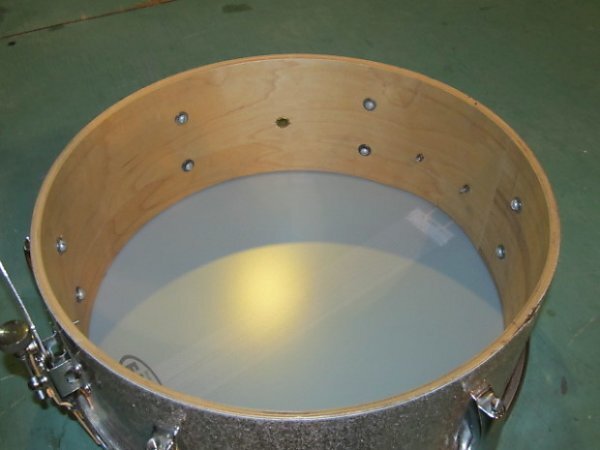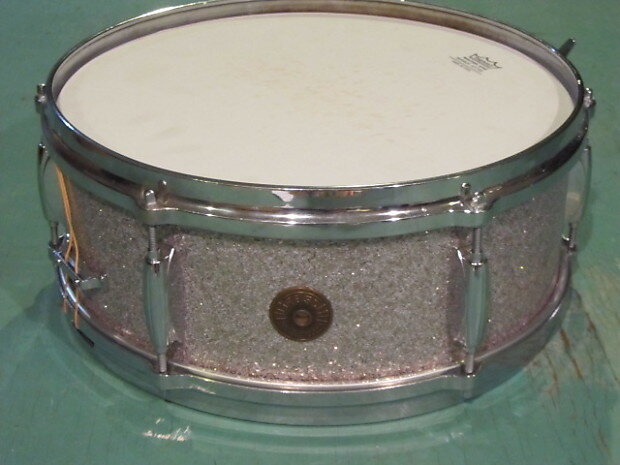Mid-1960s Gretsch Round Badge Drums without Silver Sealer
Richard E. Gier
© All Rights Reserved
One of the many unexplained mysteries of vintage drums is the existence of vintage 1960s Gretsch Round Badge drums which lack the typical silver sealer interior paint. This was an era before clear drum heads, so few people saw the inside of their drums. However, Gretsch was marketing “The Great Gretsch Sound” and part of that sound was allegedly the silver sealer they applied to the interior of their drums starting in about 1954. It seems like few would want to buy Gretsch drums which did not possess every component which contributed to the highly touted sound. While there are occasional reports of individual drums without silver sealer, one large concentrated group of such drums has been identified which were produced in the 1966/1967 time frame. These unpainted drums represent an interesting oddity and are worthy of further investigation.[i]
This particular group of drums falls in the serial number range of 72234 through 75473. The range may prove to be larger as more reports surface. Note that not all drums in this span lack silver sealer but this is only block identified which has numerous examples of drums lacking the silver sealer. Information on 116 drums in this group has been recorded, accounting for 3.6% of the 3,240 drums in this span.[ii] For 57 of these 116 drums (just under 50%), the presence or absence of silver sealer is not known. Some were just sold as labels removed from their drums. Some had no pictures of their interiors and no mention of their interior finish, so the presence or absence of silver sealer is not documented. On some, interior finish was not recorded when information was gathered for a different purpose starting fifteen years ago. There were also 16 drums which were metal shelled snares. Therefore, of the 116 reports only 43 are wood shelled drums for which the interior finish is known. Of these, 33 possess the silver sealer and ten do not. If those numbers are representative, Gretsch may have produced 2,000 or so drums which do not have silver sealer in the middle of several hundred thousand drums which do.
There does not seem to be a pattern to which drums within this serial number range received the silver sealer and which did not. The 33 drums without the silver sealer include snares, toms, floor toms, basses and marching snares. The ten with silver sealer include snares, toms, floor toms, basses and even a cocktail drum. There is nothing that jumps out of the data to indicate that the model number or size of a drum is a factor in determining when a drum might not receive the silver sealer.
One large block of 17 drums documented as lacking the silver sealer (just over half of the 33) spans serial numbers from 75037 to 75473. I owned serial number 75108, a model 4105 snare in silver glass glitter wrap, which is pictured. Within this span are two additional drums where the interior finish is not known. One was just a label being sold separate from its drum and the other was a situation where the interior finish was not noted thirteen years ago. Therefore, this particular sub-range seems highly likely to not have received the silver sealer, but it is still not clear why.
Some additional observations about this group of drums provide a little insight. There are a few reports of mixed sets where some drums have silver sealer while others do not. A Progressive Jazz set had serial numbers 72277 (8x12 Tom – unpainted), 72926 (14x14 Floor Tom – silver sealer) and 73606 (14x20 Bass – unpainted). A Name Band set had two drums with and two drums without the silver sealer – 72938 (14x22 Bass - silver sealer), 74182 (9x13 Tom – silver sealer), 74573 (16x16 Floor Tom - unpainted), 75291 (5.5x14 Snare - unpainted). There are also reports of drums where the silver sealer is present but was either very light originally or has somehow lessened over the years, like a set with the following drums: 72335 (9x13 Tom – faint silver sealer), 73316 (16x16 Floor Tom – silver sealer), no label/unknown serial number (14x20 bass – unpainted). Some sets are present today with one drum with an unpainted interior from within the relevant serial number range and other drums with silver sealer from outside this serial number range. The mixing of drums with and without the silver sealer is not surprising as serial numbers in factory born-together sets were not sequential and tended only to be within a few thousand of each other.[iii] Serial numbers were assigned in relatively numerical order, but some evidence of batching by model number is seen.[iv] Therefore, a set of drums put together for shipment and sale could logically possess painted and unpainted drums, unless a conscious effort was made to keep unpainted drums together.
Several theories have been offered for why the silver sealer is absent on some of these drums. Some suggest that these drums were made in the 1950s or using older, unpainted shells from the 1950s. However, if these drums or at least the shells are from the era before the silver sealer was introduced, they would have three ply construction. Other than the lack of silver sealer, all of these drums have physical characteristics or hardware consistent with other drums made in the 1966-67 time period, including six ply shells and thick stick badges. These do not appear to be drums from the 1950s which received 1960s labels or drums made in 1966-67 using 1950s shells.
Some believe that they are artist or endorser drums or special orders to meet customer requests. If that is the case, Gretsch would have only offered this option during one three or four months of production. Then, after making special drums without the silver sealer, they would have then had to disregard the special request and mix drums with and without the silver sealer into sets for delivery. It seems unlikely that anyone, whether an endorser or regular customer would have specifically requested a drum set where the interior finish varied from drum to drum. Further, several examples of 1970s era Gretsch drums are reported where “Special” is written on labels when drum sizes did not correspond to model numbers then in use. One might expect that drums ordered without silver sealer might have deserved a similar treatment, yet none of the 33 examples without silver sealer has anything unusual written on their labels. Therefore, it does not appear that these were special production drums.
It is also possible that some of these drums have been altered in the fifty-plus years since they left the factory. During the 1970s/1980s it became fashionable to remove resonant heads to deaden the sound. This inspired some to paint the interiors black or some other color so that the silver sealer did not stand out or detract from the stage presence of the set. In a few documented cases, the silver sealer was sanded off. The concentration of 33 drums in a relatively small range of serial numbers without silver sealer seems inconsistent with a theory that random drummers all decided to sand off the silver sealer for drums in this range. Further, if these are all post-factory modifications, everyone seems to have possessed superior craftsmanship, as the drums look like they were never painted and the labels all look like they have never been removed from their drums. This is unfortunately not the typical manner in which vintage drums have been treated. Sloppy brushwork, rattle can overspray and painting over the labels and hardware are much more common. Therefore, post-factory removal of the sealer does not appear to be the answer.
All of the above theories may have some appeal when one is presented with a single drum lacking the silver sealer, but generally fall apart when one considers the larger picture and understands the other characteristics of the other drums which share this trait.
Finally, some believe that Gretsch simply ran out of paint at some point and produced several drums without the silver sealer. This theory is the simplest and makes the most sense given the deficiencies of the other theories. Nothing about these particular drums is special, unique or remarkable, other than they lack the silver sealer. However, remember that this is still just a theory. After more than fifty years we may never know for sure why certain Gretsch drums did not receive the silver sealer interior finish. However, one should at least be aware that this situation existed, know more about the specifics of the drums without the silver sealer and avoid wild speculation about the cause.
[i] Although not part of this study, mention should be made of a group of drums from the 1968 time frame that has some interesting interior paint properties. In this range of serial numbers, the silver sealer is present but appears as silver droplets of paint in some areas and little to no paint on the remainder of the interiors of the drums. To my eye, this appears to be a defect in the finishing process that resulted from a problem with the paint adhering to the wood shell and does not appear to be an intentional effort. There are seven drums in the 100012 – 100131 serial number range which display this phenomenon, including a three-piece set where all drums had this issue.
[ii] This is slightly higher than the 3.4% of all round badge drums documented (3,975 of 116,000) in my list of vintage Gretsch drums.
[iii] Richard E. Gier, “Serial Number Ranges of ‘Born Together’ Vintage Gretsch Round Badge Drum Sets,” posted to Not So Modern Drummer on December 6, 2020, https://www.notsomoderndrummer.com/not-so-modern-drummer/2020/12/6/serial-number-ranges-of-born-together-vintage-gretsch-round-badge-drum-sets.
[iv] Richard E. Gier, Dating of Vintage Gretsch Drums Based Upon Serial Numbers: Challenging the Legend, Lore and Lies, Rebeats, Inc., 2011.
by Richard Gier © All Rights Reserved



